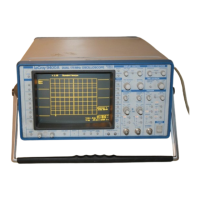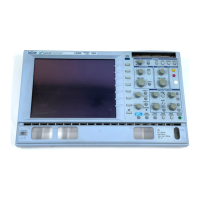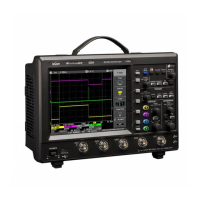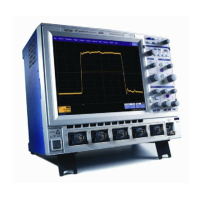D–9
Parameter Measurement
Parameter and what it does Definition Notes
maximu
m
Measures highest point in waveform.
Unlike top, does NOT assume waveform
has two levels.
Highest value in
waveform
between cursors
(See Fig. D–1)
Gives similar result when
applied to time domain
waveform or histogram of data
of same waveform. But with
histograms, result may include
contributions from more than
one acquisition. Computes
horizontal axis location of
rightmost non-zero bin of
histogram — not to be
confused with maxp.
mean
Average of data for time domain
waveform. Computed as centroid of
distribution for a histogram. But when
input is periodic time domain waveform,
computed on an integral number of
periods.
Average of data
(See Fig. D–2)
Gives similar result when
applied to time domain
waveform or histogram of data
of same waveform. But with
histograms, result may include
contributions from more than
one acquisition.
median
The average of base and top values.
Average of base
and top
(See Fig. D–2)
minimum
Measures the lowest point in a waveform.
Unlike base, does NOT assume waveform
has two levels.
Lowest value in
waveform
between cursors
(See Fig. D–1)
Gives similar result when
applied to time domain
waveform or histogram of data
of same waveform. But with
histograms, result may include
contributions from more than
one acquisition.
over−
Overshoot negative: Amount of
overshoot following a falling edge, as
percentage of amplitude.
base minimum
ampl
−
×
100
(See Fig. D–2)
Waveform must contain at
least one falling edge. On
signals NOT having two major
levels (triangle or saw-tooth
waves, for example), may NOT
give predictable results.
over+
Overshoot positive: Amount of overshoot
following a rising edge specified as
percentage of amplitude.
maximum top
ampl
−
×
100
(See Fig. D–1)
Waveform must contain at
least one rising edge. On
signals NOT having two major
levels (triangle or saw-tooth
waves, for example), may NOT
give predictable results.
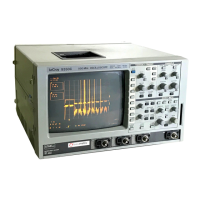
